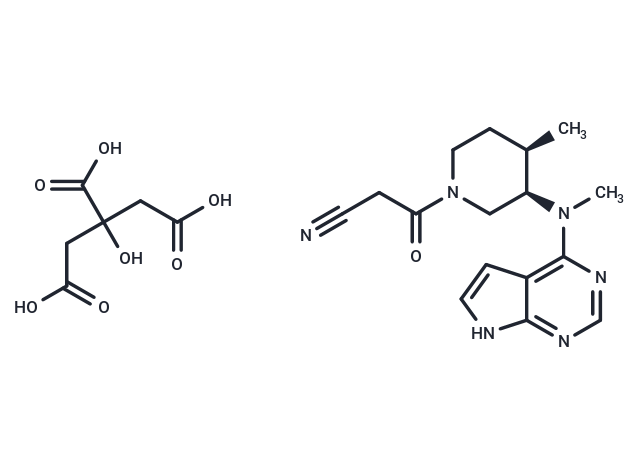Shopping Cart
- Remove All
 Your shopping cart is currently empty
Your shopping cart is currently empty

Tofacitinib Citrate (CP-690550 citrate) is a a potent, cell-permeable inhibitor of JAK1/2/3 (IC50s: 1/20/112 nM).

| Pack Size | Price | Availability | Quantity |
|---|---|---|---|
| 5 mg | $32 | In Stock | |
| 10 mg | $50 | In Stock | |
| 50 mg | $64 | In Stock | |
| 100 mg | $93 | In Stock | |
| 200 mg | $129 | In Stock | |
| 500 mg | $219 | In Stock | |
| 1 mL x 10 mM (in DMSO) | $50 | In Stock |
| Description | Tofacitinib Citrate (CP-690550 citrate) is a a potent, cell-permeable inhibitor of JAK1/2/3 (IC50s: 1/20/112 nM). |
| Targets&IC50 | JAK2:20 nM (cell free), JAK1:112 nM (cell free), JAK3:1 nM (cell free) |
| In vitro | Although Tofacitinib (CP-690,550) was highly potent for JAK3 inhibition (enzyme inhibitory potency of 1 nM), it was 20- to 100-fold less potent for JAK2 and JAK1, respectively. CP-690,550 inhibited IL-2-induced proliferation with 30-fold greater potency than its effects on GM-CSF-induced proliferation. CP-690,550 demonstrated potent inhibition in the mixed lymphocyte reaction using murine, monkey, or human cells. Consistent with its mechanism of action, these cellular activities correlated with the ability of CP-690,550 to block IL-2-induced phosphorylation of JAK3 and one of its key substrates, STAT5 [1]. CP-690,550 treatment of murine factor-dependent cell Patersen-erythropoietin receptor (FDCP-EpoR) cells harboring human wild-type or V617F JAK2 resulted in inhibition of cell proliferation with an IC50 of 2.1 microM and 0.25 microM, respectively. CP-690,550 treatment of ex-vivo-expanded erythroid progenitors from JAK2(V617F)-positive PV patients resulted in specific, antiproliferative (IC50: 0.2 microM) and pro-apoptotic activity [2]. The pharmacological inhibition of JAK3 by tofacitinib synergistically enhanced the antitumor effects of IMA in CML cells [3]. |
| In vivo | CP-690,550 treatment significantly prolonged graft survival as compared to vehicle. Four of 12 animals dosed with CP-690,550 (two from each dose group) survived to study termination with normal renal function and mild rejection as determined by histopathology [1]. Monotherapy of mice with tofacitinib quells Ab responses to an immunotoxin derived from the bacterial protein Pseudomonas exotoxin A, as well as to the model Ag keyhole limpet hemocyanin. Thousand-fold reductions in IgG1 titers to both Ags were observed 21 d post immunization. Tofacitinib treatment led to reduced numbers of CD127+ pro-B cells [4]. |
| Kinase Assay | The JAK1, JAK2, and JAK3 kinase assays utilize a protein expressed in baculovirus-infected SF9 cells (a fusion protein of GST and the catalytic domain of human JAK enzyme) purified by affinity chromatography on glutathione sepharose. The substrate for the reaction was polyglutamic acid-tyrosine [PGT (4:1)], coated onto Nunc Maxi Sorp plates at 100 μg/mL overnight at 37 °C. The plates were washed three times, and JAK enzyme was added to the wells, which contained 100 μL of kinase buffer (50 mM HEPES, pH 7.3, 125 mM NaCl, 24 mM MgCl2) + ATP + 1 mM sodium orthovanadate). After incubation at room temperature for 30 min, the plates were washed three times. The level of phosphorylated tyrosine in a given well was determined by standard ELISA assay utilizing an anti-phosphotyrosine antibody [5]. |
| Cell Research | Apoptotic cells were detected by flow cytometry using recombinant human Annexin-V conjugated with allophycocyanin. Briefly, after exposure to CP-690,550 for different periods of time, cells were washed in Ca2+-free PBS and resuspended in 100 μL of binding buffer (10 mM HEPES pH 7.4; 0.15 M NaC1; 5 mM KCl; 1 mM MgCl2; 1.8 mM CaCl2) to which Annexin-V-APC had been previously added. Cells were incubated for 20 min in the dark at room temperature, washed and resuspended in 0.3 mL binding buffer. Cells were analyzed on a FACSCalibur flow cytometer equipped with the Cell Quest Pro software [2]. |
| Animal Research | Mice received tofacitinib in PEG300 (100 mg/ml) or vehicle alone (PEG300) by osmotic pump infusion (Alzet Model 2004, 0.25 μl/hour, 28 days). Four days prior to immunization, mice were anesthetized and their dorsal surface was shaved. A one cm incision was made on the back to create a subcutaneous pocket and insert the pump. The incision site was closed with wound clips. Mice were injected weekly (i.p.) with SS1P recombinant immunotoxin (RIT; 5 μg/mouse) beginning on day 0; control mice received injections of saline alone. Every week before SS1P or vehicle immunization, ~50 μl of blood was drawn to obtain serum samples. Sera were stored at ?80°C until analyzed [4]. |
| Alias | Tofacitinib (CP-690550) Citrate, Tasocitinib citrate, CP-690550 citrate |
| Molecular Weight | 504.49 |
| Formula | C22H28N6O8 |
| Cas No. | 540737-29-9 |
| Smiles | OC(=O)CC(O)(CC(O)=O)C(O)=O.C[C@@H]1CCN(C[C@@H]1N(C)c1ncnc2[nH]ccc12)C(=O)CC#N |
| Relative Density. | no data available |
| Storage | store at low temperature,keep away from moisture,keep away from direct sunlight | Powder: -20°C for 3 years | In solvent: -80°C for 1 year | Shipping with blue ice. | |||||||||||||||||||||||||||||||||||
| Solubility Information | DMSO: 55 mg/mL (109.02 mM), Sonication is recommended. | |||||||||||||||||||||||||||||||||||
Solution Preparation Table | ||||||||||||||||||||||||||||||||||||
DMSO
| ||||||||||||||||||||||||||||||||||||

Copyright © 2015-2025 TargetMol Chemicals Inc. All Rights Reserved.